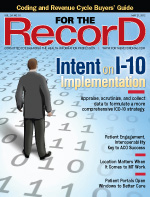 May 21, 2012
May 21, 2012
Coding for Seizures and Epilepsy
For The Record
Vol. 24 No. 10 P. 28
Seizures are episodes of abnormal electrical brain activity that cause changes in attention or behavior. The term “convulsions” may be used interchangeably with seizures, but during a convulsion, the body rapidly and uncontrollably shakes.
Epilepsy is a brain disorder in which a person has repeated seizures. Also called a seizure disorder, epilepsy may be diagnosed when the patient has two or more unprovoked seizures.
Code Assignment
A seizure episode is classified to ICD-9-CM code 780.39, Other convulsions. This code also includes convulsive disorder not otherwise specified (NOS), fit NOS, and recurrent convulsions NOS. Basically, code 780.39 is for the single episode of a seizure.
Subcategory 780.3, Convulsions, includes the following codes:
• 780.31, Febrile convulsions (simple), unspecified;
• 780.32, Complex febrile convulsions; and
• 780.33, Posttraumatic seizures.
Epilepsy and recurrent seizures are classified to category 345. Subcategory 345.9 includes the following diagnoses:
• Epileptic convulsions, fits, or seizures NOS;
• Seizure disorder NOS; and
• Recurrent seizure disorder NOS.
Types of Epilepsy
There are two main categories of epilepsy: partial (also called local or focal) and generalized. Partial seizures occur in only one part of the brain. The following are two common types of partial epilepsy:
• Simple focal seizure is a type of partial epilepsy where the awareness is retained and does not result in loss of consciousness. It may alter emotions or change the patient’s senses, such as taste or smell. This type of epilepsy is classified to subcategory 345.5, Localization-related (focal) (partial) epilepsy and epileptic syndromes with simple partial seizures.
• Complex focal seizure (subcategory 345.4) alters consciousness resulting in staring or nonpurposeful movements such as hand rubbing, chewing, lip smacking, and walking in circles.
Generalized seizures involve all parts of the brain. The following are the six types of generalized seizures:
• Absence seizures (petit mal): characterized by blank staring and subtle body movements that begin and end abruptly. It may cause a brief loss of consciousness.
• Tonic seizures: causes stiffening of the muscles and may cause the patient to fall to the ground.
• Clonic seizures: characterized by rhythmic, jerking muscle contractions that affect both sides of the body at the same time.
• Myoclonic seizures: associated with sudden brief jerks or twitches on both sides of the body.
• Atonic seizures: causes patients to lose muscle tone, so they subsequently collapse.
• Tonic-clonic seizures (grand mal): most intense type of epilepsy causing loss of consciousness, muscle rigidity, and convulsions.
Subcategory 345.0, Generalized nonconvulsive epilepsy, includes atonic and typical absences, minor and pykino-epilepsy, petit mal, and akinetic and atonic seizures. Subcategory 345.1, Generalized convulsive epilepsy, includes clonic, myoclonic, tonic, and tonic-clonic epileptic seizures; grand mal; major and progressive myoclonic epilepsy; and Unverricht-Lundborg disease.
Notice that petit mal is classified to subcategory 345.0, and grand mal is classified to subcategory 345.1. However, there are also codes available for petit mal status (345.2) and grand mal status (345.3). Status epilepticus indicates a state of continuous seizure activity lasting for a significant amount of time or having frequent recurrent seizures without regaining full consciousness in between them. This is a life-threatening condition because the brain cannot get enough oxygen to survive.
Most of the codes in category 345 require a fifth digit subclassification to complete the code. Fifth digit 0 is for without mention of intractable epilepsy. Fifth digit 1 is with intractable epilepsy and includes the terms “pharmaco-resistant,” “poorly controlled,” “refractory,” or “treatment resistant.” Codes 345.2, Petit mal status, and 345.3, Grand mal status, do not require fifth digit subclassification.
Seizures documented as the late effect of stroke are classified to code 438.89, Other late effects of cerebrovascular disease. An additional code may be assigned for the specific type of seizure/seizure disorder (code 780.39 or category 345) documented.
Coding and sequencing for seizures and epilepsy are dependent on the physician documentation in the medical record and application of the Official Coding Guidelines for inpatient care. Also, use specific AHA Coding Clinic for ICD-9-CM and American Medical Association CPT Assistant references to ensure complete and accurate coding.
— This information was prepared by Audrey Howard, RHIA, of 3M Consulting Services. 3M Consulting Services is a business of 3M Health Information Systems, a supplier of coding and classification systems to more than 5,000 healthcare providers. The company and its representatives do not assume any responsibility for reimbursement decisions or claims denials made by providers or payers as the result of the misuse of this coding information. More information about 3M Health Information Systems is available at www.3mhis.com or by calling 800-367-2447.
ICD-10-CM Coding for Seizures and Epilepsy
Coding for seizures and epilepsy in ICD-10-CM is similar to ICD-9-CM. ICD-10-CM category G40 is titled “Epilepsy and recurrent seizures.” The following are the fourth character subcategories for epilepsy:
• G40.0, Localization-related (focal) (partial) idiopathic epilepsy and epileptic syndromes with seizures of localized onset;
• G40.1, Localization-related (focal) (partial) symptomatic epilepsy and epileptic syndromes with simple partial seizures;
• G40.2, Localization-related (focal) (partial) symptomatic epilepsy and epileptic syndromes with complex partial seizures;
• G40.3, Generalized idiopathic epilepsy and epileptic syndromes;
• G40.A, Absence epileptic syndrome;
• G40.B, Juvenile myoclonic epilepsy [impulsive petit mal];
• G40.4, Other generalized epilepsy and epileptic syndromes;
• G40.5, Epileptic seizures related to external causes;
• G40.8, Other epilepsy and recurrent seizures; and
• G40.9, Epilepsy, unspecified.
Notice that the above subcategories are mainly separated by localized vs. generalized. In addition, there are separate codes if the epilepsy is idiopathic vs. symptomatic. The fifth and sixth characters will identify the presence or absence of status epilepticus and intractable epilepsy.
Convulsions, not elsewhere classified are classified to category R56 and includes the following subcategories:
• R56.0, Febrile convulsions;
• R56.1, Posttraumatic seizures; and
• R56.9, Unspecified convulsions (which includes seizures NOS).



